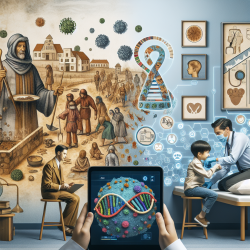Unveiling the Secrets of the Past: Lessons from Neolithic Plague Research
As a passionate advocate for data-driven decisions in speech-language pathology, I am always intrigued by how research from seemingly unrelated fields can inform and enhance our practice. One such fascinating study is the research article titled "Repeated plague infections across six generations of Neolithic Farmers," which provides insights into the spread of disease and social structures in ancient communities. While this research primarily focuses on ancient genomics and archaeology, it offers valuable lessons that can be applied to modern therapy practices, especially in educational settings.
The Power of Data in Understanding Ancient Communities
The study utilizes population-scale ancient genomics to explore ancestry, social structure, and pathogen infection among 108 Scandinavian Neolithic individuals. The findings reveal that the Neolithic plague was widespread, affecting at least 17% of the sampled population. The research demonstrates how data can unravel complex historical narratives, offering a detailed reconstruction of plague spread within a large patrilineal kinship group.
Implications for Modern Therapy Practices
While the study focuses on ancient times, its implications for modern therapy are profound. Here are some key takeaways for practitioners:
- Data-Driven Insights: Just as ancient genomics provided insights into the Neolithic community, data-driven approaches in speech-language pathology can enhance our understanding of child development and therapy outcomes. Utilizing comprehensive data can help identify patterns and tailor interventions to individual needs.
- Understanding Social Structures: The study highlights the importance of understanding social structures and kinship in ancient communities. Similarly, recognizing the social dynamics within a child's environment, including family and school, can inform therapy strategies and foster better outcomes.
- Interdisciplinary Learning: The integration of genomics, archaeology, and anthropology in the study underscores the value of interdisciplinary approaches. Speech-language pathologists can benefit from collaborating with professionals from various fields to gain new perspectives and enhance therapeutic practices.
Encouraging Further Research and Exploration
The research on Neolithic plague infections encourages practitioners to delve deeper into the historical and cultural contexts that shape human behavior. By exploring diverse research areas, we can uncover innovative strategies to improve therapy outcomes for children.
For those interested in exploring the original research paper, please follow this link: Repeated plague infections across six generations of Neolithic Farmers.
Conclusion
Incorporating insights from diverse research fields can enrich our understanding and practice in speech-language pathology. By embracing data-driven approaches and interdisciplinary learning, we can create better outcomes for children and contribute to their overall development. Let us continue to explore, learn, and innovate in our quest to support the next generation.










